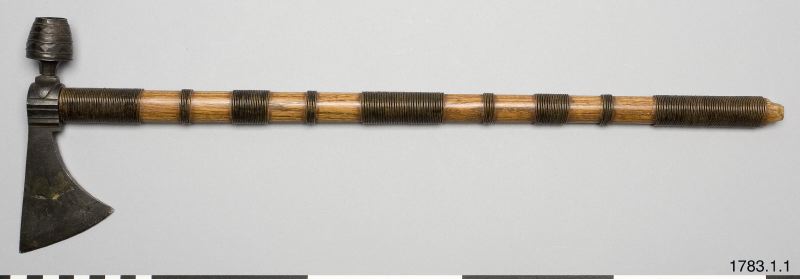| Typ <itemType> |
Objekt/föremål |
| Plats <presPlaceLabel> |
Nordamerika, Kanada, USA |
| Beskrivning <itemDescription> |
|
| Utställning / tidigare <itemDescription> |
|
| Utställning / tidigare <itemDescription> |
|
| Utställning, del av / tidigare <itemDescription> |
|
| Entré till samlingen <itemDescription> |
-
For information about the important pipetomahawk, see e.g. Brunius, "In the light of New Sweden..." ( ERNAS, 2007//2010); Brunius, "Prosten Carl Magnus Wrangels betydelsefulla... (Med Världen i Kappsä...
Visa hela
For information about the important pipetomahawk, see e.g. Brunius, "In the light of New Sweden..." ( ERNAS, 2007//2010); Brunius, "Prosten Carl Magnus Wrangels betydelsefulla... (Med Världen i Kappsäcken, 2002); Brunius, "Some comments on early..." (New Sweden in America, Hoffecker et al, ed, 1995);
Linné, "Three North American Indian Weapons..." (The Connoisseur, 1958); for a certain pouch, see Brunius (in press, as above, ERNAS, 2009/2010); Kasprycki, "Quilled Drawstring Pouches... (American Indian Art Magazine, 1997). (SB, 2010-01-14). It is an odd circumstance in the original Wrangel description 1783.1.1. , i.e the pipetomahawk , that the calumet phenomenon is mentioned . The calumet was the true peace pipe and consisted more than often of a long stem/shaft , a stone pipehead (sometimes made of catlinite) and decorated with e.g. feathers . It is indeed hard to believe that a pipetomahawk could be considered to be a calumet . Maybe the explanation in the 1783.1.1. case is that the great General William Johnson (1715-1774) had said to Carl Magnus Wrangel that the pipetomahawk in question was almost as important as a calumet . And over time in Wrangel´s personal view the pipetomahawk became a calumet . One should keep in mind that Carl Magnus Wrangel had much less insight in Native American culture compared to that of General Johnson . In all cases , both calumets and pipetomahawks were most likely present in the Easton peace treaty meeting of 1758 . (S B-s, 2021-12-08)
Stäng
|
| Referens, publicerad i <itemDescription> |
|
| Referens, publicerad i <itemDescription> |
-
Brunius, Staffan (2002) En tomahawk från Nya Sverige? I Med världen i kappsäcken. Samlingarnas väg till Etnografiska Museet, ed. W. Östberg (Stockholm, 2002), pp. 18-19
|
| Referens, publicerad i <itemDescription> |
|
| Land / engelska <itemDescription> |
|
| Land / engelska <itemDescription> |
|
| Geografiskt namn / annat <itemDescription> |
|
| Geografiskt namn / annat <itemDescription> |
|
| Händelse <context> |
-
Insamlad av Wrangel, Carl Magnus.
-
Ursprung i Kanada, USA, Nordamerika.
-
Utställd 1878 - 1879 i Arvfurstens palats, Stockholm av Nordamerika (2008), Allmänna etnografiska utställningen 1878-79.
|
| Material, engelska<itemMaterial> |
- copper
- iron
|
| Materialkategori<itemMaterial> |
- metall
- trä
|
| Material<itemMaterial> |
- trä
- järn
- koppar
|
| Nyckelord <itemKeyWord> |
-
1783.01.0001
-
Drikker, nytelsesmidler og legemidler (no) (270)
-
EU.189:723
-
I ljuset av nya Sverige
-
RM.723
-
Redskap och verktyg (410)
-
Tobak, narkotika, droger (276)
-
Vapen (411)
|
| Mått <itemMeasurement> |
-
Längd: 49,5 cm. skaftet
-
Bredd: 15,5 cm. yxbladet
|
| Sakord, engelska<itemName> |
- pipe
- axe
- tomahawk
|
| Sakord<itemName> |
- yxa
- tomahawk
- pipa (rök)
|
| Ämne <subject> |
|
| Inventarienummer <itemNumber> |
|
| Tidigare identitet <itemNumber> |
|
| Tidigare identitet <itemNumber> |
|
| Rättigheter för metadata <itemLicense> |

|
| Källa <presOrganization> |
Statens museer för världskultur - Etnografiska museet |
|
Källa <url>
|
|








 ARTIKLAR I WIKIPEDIA
ARTIKLAR I WIKIPEDIA ARTIKLAR I WIKIDATA
ARTIKLAR I WIKIDATA BILDER I WIKIMEDIA COMMONS
BILDER I WIKIMEDIA COMMONS











